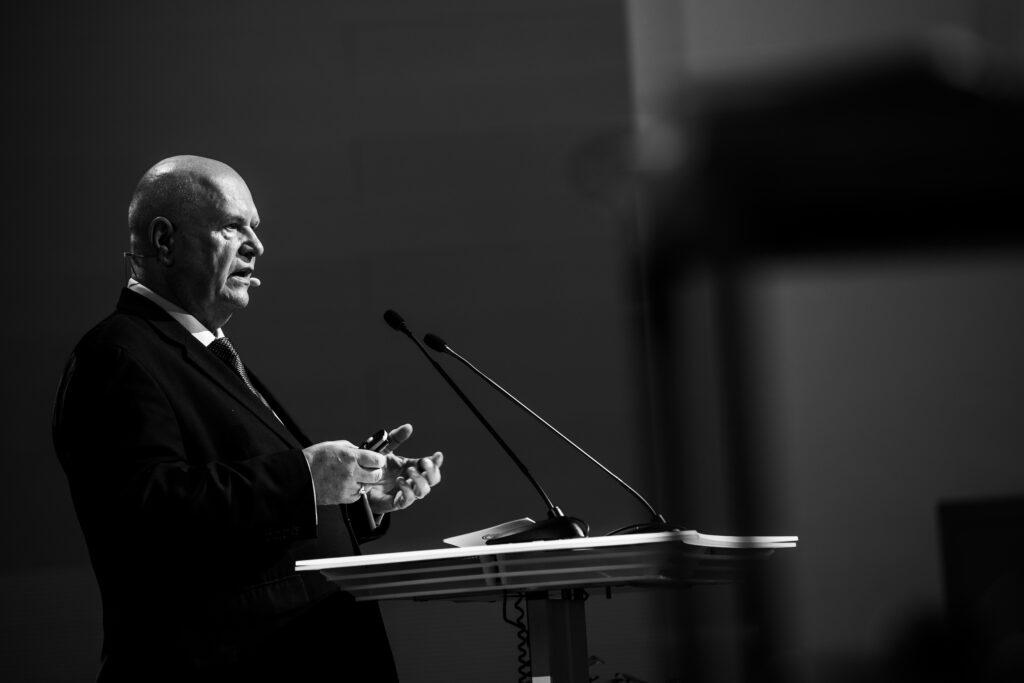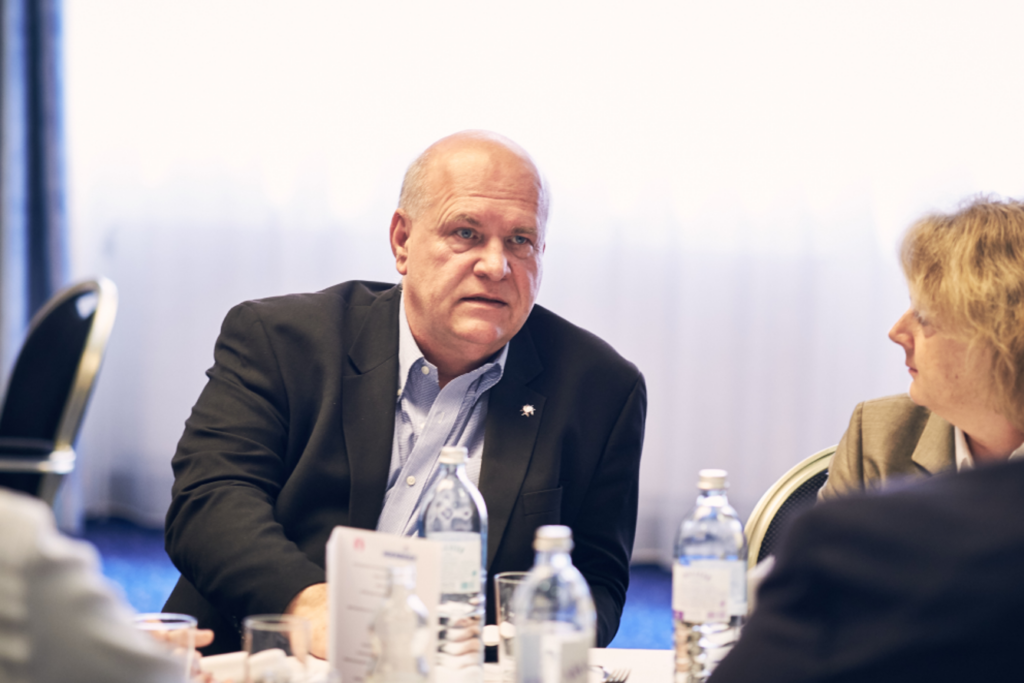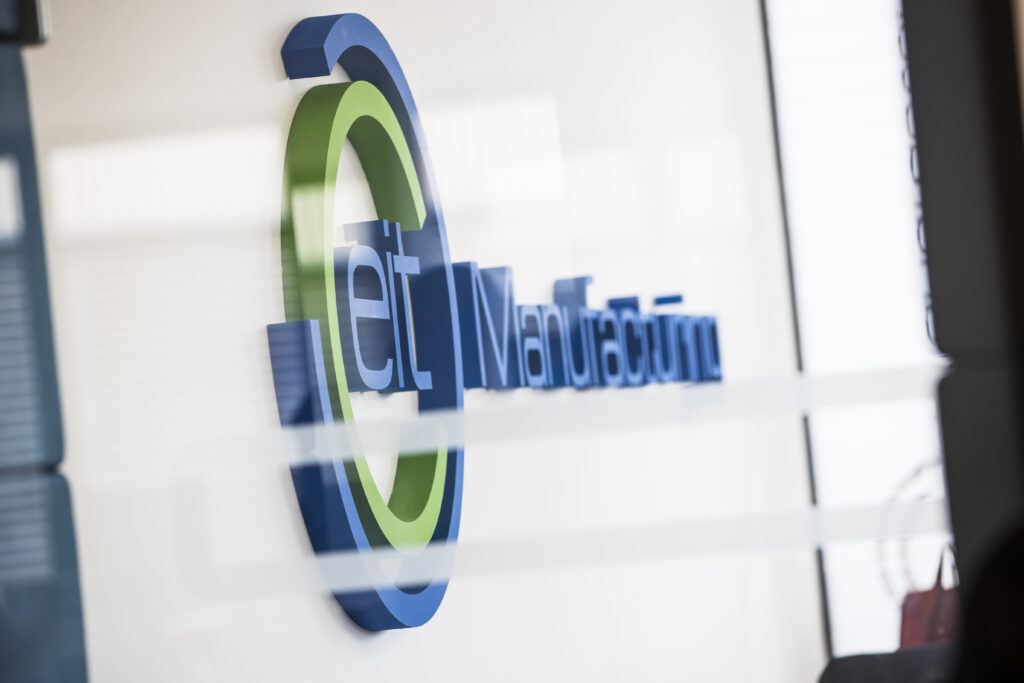Slovenia’s innovation potential is based on its manufacturing heritage and scientific and research talents
In an interview for IRT3000 magazine, Johannes Hunschofsky, Managing Director of EIT Manufacturing East discusses the future of European manufacturing in the dawn of AI, Slovenia’s rich industrial heritage, and much more. Read the entire interview in English below. The original article in Slovenian, written by Jernej Kovac, can be found here.
Q: Technological advances, climate change and geopolitical tensions have changed the global manufacturing landscape. Where does European manufacturing stand today compared to its global competitors?
The primary focus for the manufacturing sector moving forward will revolve around transitioning to a circular economy – a shift we view as an opportunity rather than a challenge. There will be a growing demand for remanufacturing and sustainable manufacturing technologies, and we are committed to helping European manufacturers in leading these markets.
While European manufacturing may lag behind in certain areas compared to global competitors such as China or the U.S., we should not dismiss its crucial role in transforming the global manufacturing landscape into a more innovative and sustainable one. For example, there are many great startups in Austria. In fact, Austria has the highest number of Additive Manufacturing startups per capita worldwide, and in total numbers, Austria is on the third place globally. Many of those startups are so-called hidden champions operating in the B2B area, with very high ROIs, even higher than for U.S. startups. However, when it comes to Artificial Intelligence and some deep tech areas, China and the United States are still ahead of European companies.
At EIT Manufacturing, our priority is to align our actions with the needs of the market and our stakeholders. We concentrate our efforts on four key thematic areas: Flexible Production Systems, Low Environmental Footprint Systems & Circular Economy, Digital & Collaborative Solutions, and Human-Machine Co-Working. These flagship areas are continuously refined in collaboration with our manufacturing community to address the industry’s most critical challenges effectively. We are doing that through thematic working groups acquiring feedback from the manufacturing industry in Europe.
Q: What are the main differences between Europe, the U.S., India and China in the manufacturing industry?
A strong manufacturing sector is key for prosperity and wealth in every country, and consequently in Europe as a whole. Europe, the U.S., India, and China differ in manufacturing due to factors like technological advancement, regulatory frameworks, labour costs, and market dynamics.
For example, in Europe, we prioritise sustainability and quality, while China focuses on scale and cost-efficiency. China has greatly benefited from its low labour costs over the past few decades, but now we see India gradually stepping into a similar role. As a result of that, China has been able to build a strong manufacturing ecosystem that has put them at the top of many innovation areas. Europe and, to some extent, the United States are already emphasising manufacturing activities with a focus on sustainability and environmental protection. However, recent disruptions in the global supply chains, such as the microchip shortage and the Suez Canal blockage, have highlighted the critical dependency of European manufacturers on Asian suppliers. This realisation has prompted efforts to bring manufacturing closer to Europe, often to Southeastern European countries, which enhances our control over the regional supply chains.

Photo Credit (c) Matthias Heschl
Q: Artificial Intelligence and deep technology are also shaping movements in the capital markets and are likely to continue to do so. How is EIT Manufacturing responding to these developments?
We certainly cannot deny the appeal of AI in production. It promises efficiency, precision, and reduced labour costs. The current AI developments in the B2C market also motivate various organisations to question the need, significance, and implementation of AI applications in production.
In the manufacturing industry, there has always been a push for digitisation amidst the complexities of AI, data services, interfaces, and increasing regulations. From the era of Computer Integrated Manufacturing (CIM) in the 80s and 90s to the advent of Industry 4.0 in the 2010s, and now the focus on AI, the goal is all the same: digitising production to stay competitive. Ultimately, AI can streamline processes in businesses and organisations, leading to cost savings, better resource management, and optimised workflows.
Hence, at EIT Manufacturing, we are actively seeking and supporting startups developing AI technologies. Equally important is our focus on education and training, ensuring that both current and future employees are equipped with the skills to leverage AI effectively across all levels of manufacturing operations. Creating a culture of continuous learning and adaptability is essential for organisations to embrace AI and other emerging technologies successfully.
Q: How are European policies influencing the functioning and development of EIT Manufacturing? What is the medium-term vision of EIT Manufacturing?
European policies and regulations present a mixed bag of challenges and opportunities for corporations, especially SMEs. While certain regulations like the product passport and material recirculation rules may pose difficulties for companies, they also set standards that pave the way for new opportunities and businesses to be created. These policies are driving a shift towards sustainability and environmental protection, which are increasingly crucial not only for Europe, but for the whole world.
In response to these policy dynamics, EIT Manufacturing is strategically positioning itself to capitalise on emerging trends. Our medium-term vision involves the creation of a “European Manufacturing System” rooted in sustainability. We recognise sustainability as a fourth critical factor, alongside quality, cost, and time, influencing decision-making in manufacturing companies. By aligning with these policy objectives and leveraging mid- to long-term perspectives, we aim to shape a manufacturing landscape that not only meets regulatory standards, but also drives innovation and growth.
Q: Creating a strong industrial base also means supporting new and growing companies. How do you explain the fact that Europe is lagging behind other industrial giants when it comes to setting up unicorn companies?
Europe lags in creating unicorn companies due to various factors, including regulatory hurdles, limited access to venture capital compared to other regions, and fragmented markets. Organisations such as EIT Manufacturing play an important role in supporting entrepreneurship, innovation, and scaling up new ventures to address this gap in an early stage.
Yet, the reality is that when it comes to scaling up and actually creating unicorns, we are still falling short compared to the U.S. Their venture capital market is simply larger, structured differently, and considerably less risk-averse. In comparison, the European Innovation Council (EIC) under the Horizon Europe programme is targeting high-risk corporations and scaleups with great potential and we have already seen the first positive signals from this initiative. However, there is a need for further refinement to effectively meet the needs of the European business community.

Johannes Hunschofsky and Ann Campbell from Caltech
Q: Francisco Betti, Head of Global Industries at the World Economic Forum, emphasises the need for closer collaboration between businesses and governments in the face of disruption to manufacturing caused by geopolitics, climate change and the fourth industrial revolution. Investing in reskilling and upskilling, and making manufacturing more attractive to new generations is another priority for the global manufacturing community. “We need to make sure that we scale the adoption of technology in a way that works for all,” Betti said at the recent World Economic Forum. What role, what contribution does EIT Manufacturing make in this context?
EIT Manufacturing fosters collaboration between businesses and governments, invests in reskilling and upskilling programmes, and promotes technology adoption that aligns with sustainability and inclusivity goals. By focusing on innovation and addressing industry challenges, EIT Manufacturing aims to drive positive change in the manufacturing sector.
Additionally, we are committed to addressing the number one need of our industry: upskilling and reskilling. Through our extensive network of partners and educational programmes, we promote initiatives that ensure that individuals are prepared to leverage emerging technologies and adapt to new market dynamics.
Q: Businesses must create a robust learning culture and adjust to the needs of the market. EIT Manufacturing is helping companies in achieving this by analysing the maturity level of their learning initiatives and offering individual solutions to our industry partners.
We are also committed to making manufacturing attractive to younger generations. By collaborating with Junior Achievement Europe, we want to foster entrepreneurship among students and help them enter the market. We believe that early opportunities like this support the next generation of innovators across Europe.
Q: Is the energy, effort and action you are pursuing at EIT Manufacturing and introducing to stakeholders a unique opportunity to create a kind of new European manufacturing system?
EIT Manufacturing’s initiatives present a unique opportunity to drive innovation, sustainability, and resilience in the European manufacturing sector. In response to the numerous challenges our industry faces, EIT Manufacturing advocates for a re-thinking of manufacturing, emphasising what and how we manufacture. Central to this transformation is the deployment of process innovation, incorporating people, processes, and technologies. Sustainability is not merely an optional add-on, but a mandatory priority, driving a shift towards circular economy principles, decarbonisation, and reduced energy consumption. Moreover, a human-centred approach is critical in this transformation, as proposed by the European Commission under Industry 5.0.
In collaboration with partners and contributors, EIT Manufacturing has taken the initiative to put forward the ’European Manufacturing System’ as a strategic objective, aimed at overcoming traditional barriers between enterprises through an ecosystem approach. This system prioritises sustainability and envisions autonomous, self-organised production and logistics. EIT Manufacturing serves as a powerful ecosystem connecting diverse networks and expertise essential for the transformation of industry.
“Manufacturing is vital to our economic and national security, and we must scale advanced manufacturing systems hand-in-hand with sustainability,” said John Hart (Professor and Head, MIT Department of Mechanical Engineering) at the Manufacturing@MIT Symposium last year. Where do you see the biggest challenges for the EIT Manufacturing East countries, especially Slovenia, in the manufacturing industry?
“There are three main challenges most European countries face. Firstly, navigating EU regulations can be cumbersome for corporations, particularly SMEs. Secondly, there is a need to overcome reservations about collaboration and ecosystem-building among companies. Organisations need to learn to work together to find and take advantage of these win-win situations that arise from successful collaboration. Thirdly, talent shortage remains a significant risk. However, Slovenia has made considerable progress in recent years, and we see numerous opportunities for growth and development, especially with support from organisations like EIT Manufacturing to overcome these challenges.”
Hannes Hunschofsky, Managing Director, EIT Manufacturing East
Q: How do you rate the Slovenian industry’s adaptation to global conditions, speed and responsiveness, especially in unpredictable situations?
If we look at the European Innovation Scoreboard, a tool that provides a comparative assessment of the research and innovation performance of EU Member States, we can see that Slovenia is classified as a moderate innovator with a performance score that is above the average of the other moderate innovator countries.
We see significant innovation potential within Slovenia’s manufacturing ecosystem, particularly when it comes to the country’s rich manufacturing heritage and the exceptional talent pool emerging from universities and research institutes like our esteemed partners, the Jozef Stefan Institute and the University of Ljubljana. There are numerous opportunities available for Slovenia, its government, and authorities to leverage, including but not limited to EIT Manufacturing. We remain committed to supporting these efforts and contributing to your country’s success.
Q: Apart from the challenges, you also know our strengths, weaknesses and shortcomings. Could you perhaps give a concrete practical example?
Our first investment in the Central and Eastern European region is in SaleSqueze, a Slovenian startup, which joined our startup portfolio in 2021 and is currently receiving support for international expansion. Furthermore, we are actively engaged in fostering the Slovenian startup community, having facilitated the creation of at least three new industrial ventures through our innovation initiatives. These startups will continue to thrive with the business development assistance provided by our team.
Additionally, in the past year we have collaborated with the Jozef Stefan Institute on a project entitled “Anisotropic Fast PROtotyping of MAGnetic Materials” focusing on magnetic materials manufacturing, which highlights Slovenia’s leading role in this emerging field.
Q: In your opinion, what is a vision for the next era of manufacturing that includes scaling new technologies and businesses, prioritises sustainability and resilience, creates quality jobs and strengthens the economy in the EU and globally? What needs to be done to achieve this?
The future of manufacturing is not about one new technology, but rather about a multitude of innovations from startups that will be adopted by larger corporations. The next era of manufacturing should prioritise sustainable practices, innovation, and inclusivity. This involves scaling new technologies such as AI, IoT, and advanced robotics while promoting circular economy principles and reducing environmental impact.
We should also not forget the crucial role of talent and skills when it comes to the future of manufacturing. We need to make sure people are equipped with the right digital skills for the job. It is essential to design appropriate training to fill these well-paying jobs with the next generation of machine operators.

Photo Credit (c) Matthias Heschl
Q: How do you recognise the talent in the industry, the people who make a difference, who add significant value? How to retain them, motivate them to develop their versatility and excel in their field, fearless and satisfied?
Recognising talent in the industry involves identifying individuals who demonstrate a commitment to continuous learning and a proactive approach to seeking new opportunities. Those who enrol themselves in ongoing education and training, as well as actively search for ways to expand their skill set, are often the ones who make a significant difference and add value to their field. Additionally, flexibility in career paths, including the willingness to change jobs or roles multiple times throughout their career, indicates adaptability and a drive for growth.
To retain and motivate such talent, it is important to create an environment and culture that fosters continuous learning and professional development. Providing individuals with new responsibilities, challenges, and opportunities for growth can keep them engaged and satisfied in their roles.
Q: Young people are the future, we need to invest in them. That is a must. How should this be done, how does EIT Manufacturing do it?
Nurturing the next generation of talent is absolutely crucial for the future of manufacturing and we recognise that at EIT Manufacturing. There is this misconception that manufacturing is kind of outdated, a field that is not attractive to young people. However, in reality, manufacturing is incredibly tech-driven, and there are many exciting opportunities for young people looking to start their career in the field.
At EIT Manufacturing, we try to show the dynamic and innovative side of manufacturing to young people. We actively support and participate in initiatives like Junior Achievement to drive excitement and awareness about the industry among high school students. We see how crucial it is to train young people in fundamental skills like mathematics and data interpretation, which will be a very useful skill set for the future.
Who do you think should be managing the technology that drives humanity and teaches every child and manages our government — who is really leading this field that can build these models and do these things?
“All stakeholders need to collaborate to effectively lead this process. This means involving a mix of industry experts, policymakers, educators, and scientists, all working together. At the same time, I want to emphasise the need for collaboration between regulators and the private industry. Both are essential – one cannot function effectively without the other. Take the ethical dimension of AI, for instance. While regulation is necessary, it should not stifle innovation. Overregulation could drive certain activities underground, hindering the development of AI. It is important that individuals and companies learn to navigate new technologies ethically. This requires both societal pressure and educational focus on ethical tech use.”
Hannes Hunschofsky, Managing Director, EIT Manufacturing East

